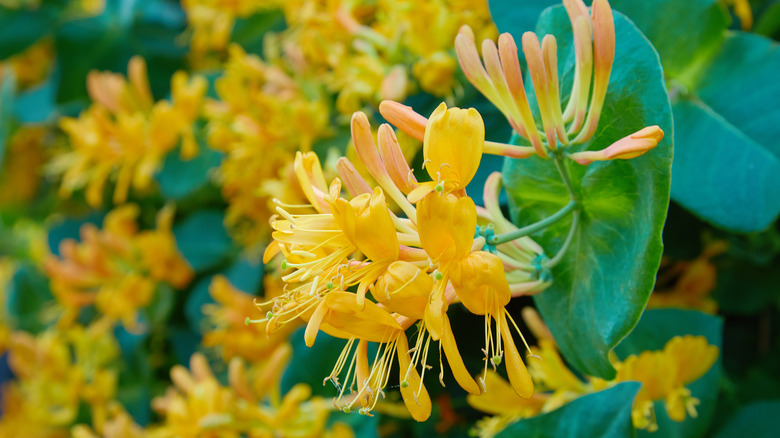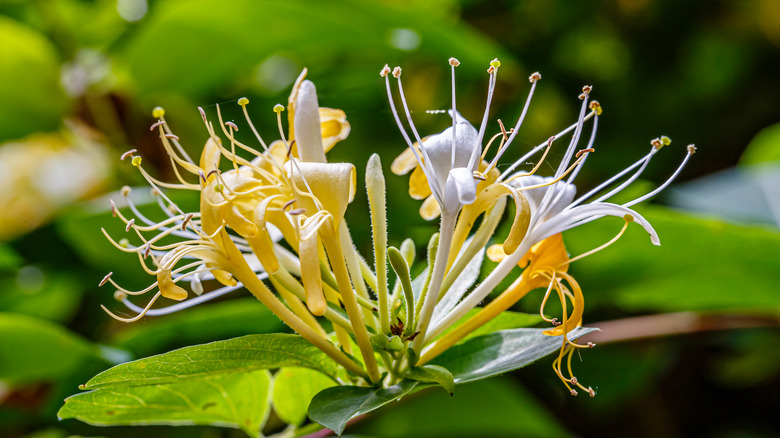Why This Common Honeysuckle Plant Is One You Don't Want To See In Your Garden
Gardening, while rewarding, is also a challenging hobby — especially when it comes to trying to figure out what should and shouldn't be in your yard. There are weeds you shouldn't pull because they are beneficial native plants and ornamental flowers (like butterfly bushes and creeping bellflower) that are beautiful but highly invasive and should never be planted. Japanese honeysuckle falls into the latter category of beautiful but invasive plants. The biggest problem with Japanese honeysuckle is that it is not considered an invasive species in every U.S. state — which means that you can find this sweet-smelling and beautiful flower at some garden centers despite its negative environmental impact. Another problem is that the Japanese honeysuckle (Lonicera japonica) looks quite similar to its native counterpart, coral honeysuckle. However, Japanese honeysuckle is much more damaging to the environment and can even be dangerous if consumed by humans or pets.
The easiest way to know if you have Japanese honeysuckle in your yard is by looking at the way it is growing. Japanese honeysuckle typically has flowers that start white and then turn yellow (and eventually become dark-colored berries). This is a quick-growing woody vine that wraps itself around tree trunks and other stationary objects but doesn't grow in aerial roots or tendrils like its native cousins.
How Japanese honeysuckle can hurt your yard
The main reason why you don't want Japanese honeysuckle in your yard (and also why it is considered invasive) is because it grows very quickly in dense leaf-covered vines that are capable of covering an area of earth and smothering out native flowers and plants. Furthermore, Japanese honeysuckle, when allowed to grow vertically, can even create a high canopy that can block lower-growing flowers and vegetables in your garden from getting sunlight causing them to slowly shrivel and die. The vines of this plant are woody and strong and can even kill young trees by wrapping around them and choking them.
Unfortunately, like most invasive plants, Japanese honeysuckle is pretty hard to get rid of once you have it. The biggest issue is that the plant's woody stalks and vertical growth make it so you can't run it over with a lawn mower or pull it effectively. The best method to remove this prolific grower is to cut the vines down and then treat them with herbicide. However, herbicides are full of harmful chemicals that can also easily damage nearby plants and other areas of your yard, especially if you apply them on a windy day.
How Japanese honeysuckle can hurt you
On top of damaging your yard and your other plants, the berries of a Japanese honeysuckle plant can also be toxic to humans if eaten in large quantities. This makes it especially dangerous for children who are smaller in size and might eat the berries out of curiosity. Symptoms of Japanese honeysuckle poisoning include upset stomach, vomiting, a quick heartbeat, cold sweats, and possibly even coma. While Japanese honeysuckle is typically not life-threatening for humans, the entire plant (including the flowers) is toxic to dogs and cats. So, if you have one of these plants, make sure to keep your furry friends away.
On top of this, Japanese honeysuckle can also cause skin irritation for gardeners who are trying to work around the plant or manage its growth spurts. This makes dealing with the invasive flower all the more irritating. So, (if you have the choice) instead of planting Japanese honeysuckle in your yard, try and go for the environmentally-friendly native coral honeysuckle instead. Other options for similar vine-like quick-growing plants with beautiful flowers include crossvines, trumpet flowers, white-leaf leather flowers, and Carolina jessamine.


